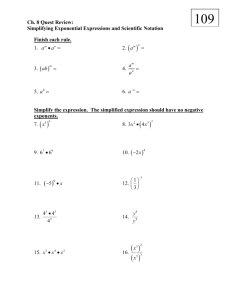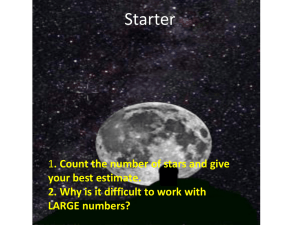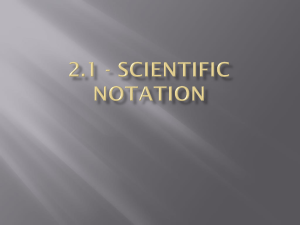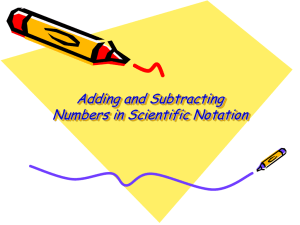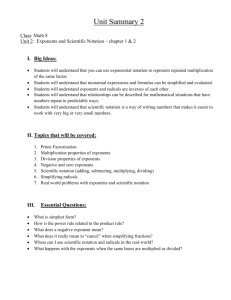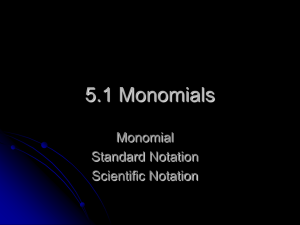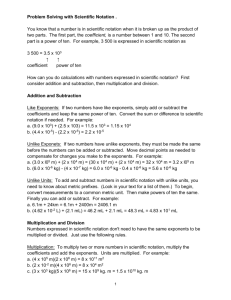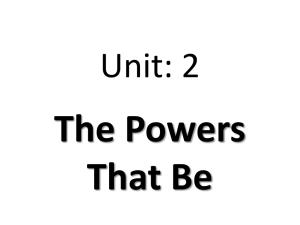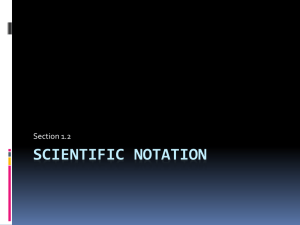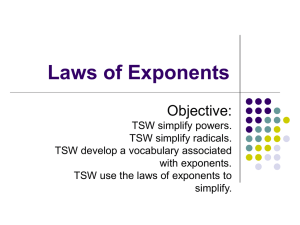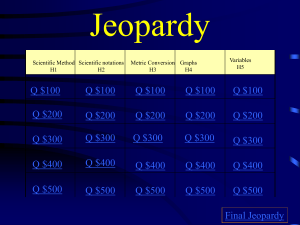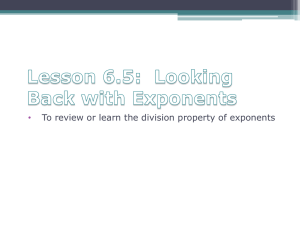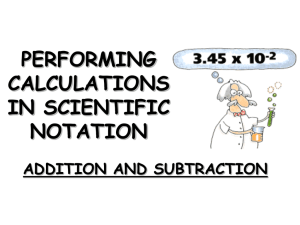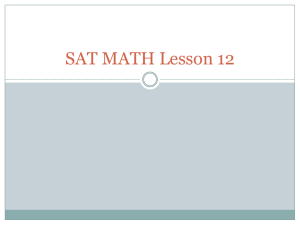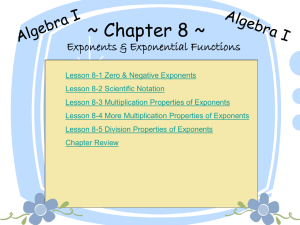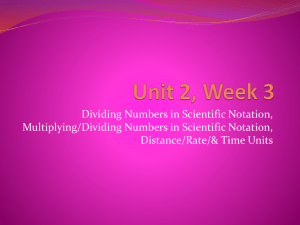Exponential Form and Scientific Notation.ppt - pams-zell
advertisement
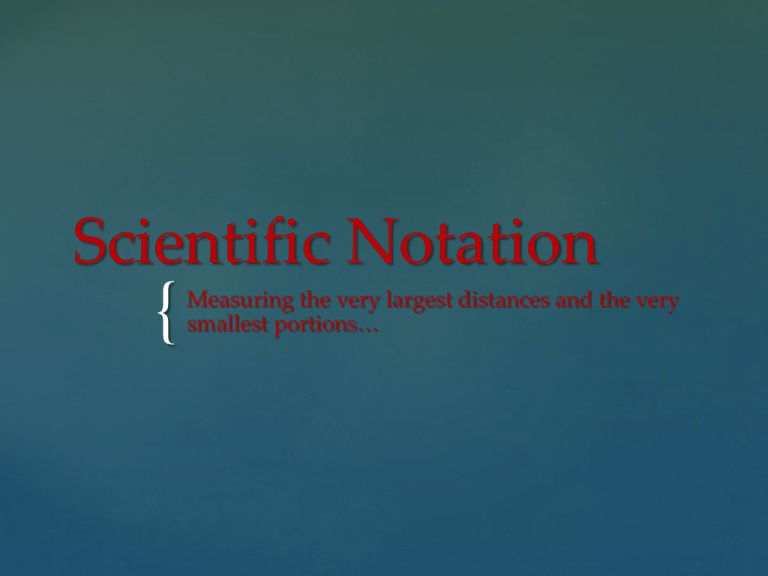
Scientific Notation
{
Measuring the very largest distances and the very
smallest portions…
In order to understand “scientific notation” we first need to
understand exponents. Most of us understand the concept –
because we know the numbers 1 – 12 “squared.”
12 = 1
22 = 4
32 = 9
42 = 16
52 = 25
62 = 36
72 = 49
82 = 64
92 = 81
102 = 100
112 = 121
122 = 144
Understanding Exponents
We can figure these in reverse as well! This is taking the
square root of a number!
√144 = ____
√121 = ____
√81 = ____
√100 = ____
√1
= ____
√4 = ____
√9
= ____
√25 = ____
√36 = ____
√16 = ____
√64 = ____
√49 = ____
Square Roots
You should know by now that a
number “squared” is just a number
being multiplied by itself!
Consider the equation:
22 = 4
We know that this is just another
way to state:
2 x 2 = 4.
So what about this slightly
different equation:?
{
base
exponent
3
2
Other Exponential Forms
Exponent
Base
3
2
So what is the value of 23?
{
Two to the third power =
3
2
=
{
2x2x2=
8
Two cubed equals eight.
What other examples can we solve involving cubed numbers?
A. 13 = 1 x 1 x 1 =
_____
E. 63 = 6 x 6 x 6 = _____
B. 33 = 3 x 3 x 3 =
_____
F. 73 = 7 x 7 x 7 = _____
C. 43 = 4 x 4 x 4 =
_____
G. 83 = 8 x 8 x 8 = _____
D. 53 = 5 x 5 x 5 =
_____
H. 103 = 10 x 10 x 10 =
…and we can keep this up all day!
Any number to the power of zero is equal to one.
This is true no matter how larger or small a number is
– and no matter whether the number is positive or
negative.
Example 1.
Example 2.
Example 3.
5870 = 1
550 = 1
10 = 1
The only exception to the rule would be 00, because
zero to the zero power is undefined. It doesn’t exist.
Special Exponents: n0
Any number to the power of one is equal to the
number!
This is true no matter how larger or small a number is
– and no matter whether the number is positive or
negative.
Example 1.
Example 2.
Example 3.
5871 = 587
551 = 55
11 = 1
Special Exponents: n1
Solve these equations with exponents!
A. 23430 = _____
B. 3451 = _____
C. -2580 = _____
D. -8541 = _____
E. 2651
= _____
F. 01
= _____
G. 53
= _____
H. 24
= _____
Practice with exponents!
The number ten is a very important one in
mathematics – and for many reasons. Our system of
counting is a base ten system. Meaning that the
concept of “place value” in our counting is achieved by
advancing in units of ten!
For example , ten units of one = 10.
And ten units of ten = 100.
Ten units of 100 = 1000; ten units of 1000 = 10, 000. And
so on, infinitely!
This is place value. And you understand it, right?
n
10 to Exponential Powers, or 10
Here are some very simple examples:
A.
B.
C.
D.
E.
7
45
659
10,000
89,899
<, >, or =
<, >, or =
<, >, or =
<, >, or =
<, >, or =
10
100
1,000
1, 000
100,000
Examples of place value!
You know that 7 is less than 10, even though
the number seven is larger than both 1 an 0 – or
even 1 and 0 combined.
You know that 10,000 is greater than 1,000 even
though the numbers involved are essentially
the same.
And you know that 89, 899 is still less than
100,000 – even though every number in 89, 899
is larger than the 1 and zeroes in 100,000!
We know about place value!
Scientific notation is simply another way to
measure place value. We use scientific notation
in two basic contexts!
1. When we are using extremely large
numbers!
OR
2. When we are using infinitesimally small
numbers!
Scientific Notation
{
Consider this example: What is the distance from the Earth to
the Sun in miles?
The answer is approximately 93 Million miles!
We can write this out longhand – 93, 000, 000 miles.
Or, we can abbreviate the number using scientific notion.
The Distance from the Earth to the Sun!
{
9.3 X
The Earth is 93,000,000 miles
from the Sun.
7
10
miles from the Sun.
Because our system of place value is base ten, we can
easily measure large numbers – and smaller numbers,
too – by using our knowledge of the number ten’s
exponential values!
CHECK IT!
100 =
101 =
102 =
103 =
104 =
1
10
100
1000
10000
105 = 100000
106 = 1000000
107 = 10000000
108 = 100000000
109 = 1000000000
Ten to the nth power! And we can do
this for any power of 10… Infinitely!
Consider these examples:
A.
The distance between the Sun and the planet
Jupiter : 483, 700, 000 miles.
B.
The number of people on the planet Earth.
Total population: 6, 960, 000, 000.
Representing large numbers in
Scientific Notation.
Since we all know the value of 10n, we are able to
use exponents of ten to represent the place value of
large numbers.
The distance between the sun and the planet Jupiter,
then, becomes this multiplication product: 4.837 x
108.
We know the value of 108 is 100, 000, 000. And the
“significant figures” or “sig figs” in the expression
are used to create a “shorthand” multiplication
problem.
4.837 x 100, 000, 000 = 483, 700, 000.
Numbers in Scientific Notation.
Since we all know the value of 10n, we are able to
use exponents of ten to represent the place value of
large numbers.
The population of the planet Earth, approximately
6.96 billion people, or 6, 960, 000, 000 becomes this
multiplication product: 6.96 x 109.
We know the value of 109 is 1, 000, 000, 000. And the
“significant figures” or “sig figs” in the expression
are used to create a “shorthand” multiplication
problem.
6.96 x 1,000, 000, 000 = 6, 960, 000, 000 or 6.96 Billion!
The World Population in
Scientific Notation.
A shorter method of writing numbers in
scientific notation is to identify the exponent of
10 in the number and literally move the
decimal by that number of “places.”
Consider these examples. Note that the .0 at
the end of each number does not change it’s
value at all! 1.0 = 1, right?
A. 1.000 x 103 = 1, 000.0
B. 7.55 x 106 = 7, 550, 000.0
C. 3.65 x 1021 = 3, 650, 000, 000, 000, 000, 000, 000.0
When we multiply by ten…
Write each of the numbers below in Scientific
Notation:
A. 7,000, 000, 000
C. 5,000
E. 63, 000, 000
B. 8, 500, 000
D. 25, 000, 000, 000
F. 9, 600
G. The United States of America’s current
national debt: $14, 700, 000, 000, 000.
(Yes, you need to use scientific notation for that!)
Practice? We talkin’ about practice?
